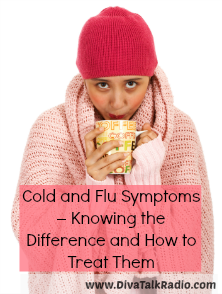 “Oh no,” you think. “I’m coming down with a cold. Or is it the flu?” Do you know how to tell the difference and do you know how to treat them? Luckily, it is possible to know the difference between the cold and the flu. Keep reading to learn more.
“Oh no,” you think. “I’m coming down with a cold. Or is it the flu?” Do you know how to tell the difference and do you know how to treat them? Luckily, it is possible to know the difference between the cold and the flu. Keep reading to learn more.
Symptoms of the Common Cold
A cold is a mild respiratory condition that usually begins with a sore throat. You may also experience congestion or runny nose. Coughing is also associated with having a cold. While children may develop a fever with a cold, it is rare that an adult will. Taking your temperature is one sure way of telling whether an adult has a cold or if it’s something else. An adult may develop a mild temperature, but it won’t be more than a point or two.
How to Treat the Common Cold
A cold will last about seven to ten days. Even though there are over-the-counter products which will help reduce the symptoms of a cold, it will normally work its way through your system in the same amount of time whether you take anything or not. To treat a cold, consider taking a decongestant and a pain reliever.
Be sure to wash your hands often throughout the day. Cover your mouth when you cough or sneeze to ensure you don’t pass the cold to others. Rather than covering with your hand, so that you would then have to wash your hands again, cough into your elbow.
Get plenty of rest when you have a cold. Instead of going to work or school, it would be better to stay at home, rest and get plenty of liquids. This will help you recover and keep you from spreading your cold.
If it seems your cold isn’t going away, it may be possible that you don’t, in fact, have a cold. Quite often people mistake hay fever (allergic rhinitis) or sinus infection for a cold. If you don’t get better after seven days, it may be a good idea to check in with your doctor. They will be able to tell you if there is something else causing your illness.
Symptoms of the Flu
The flu is a viral infection that is considerably more severe than a cold. It isn’t unusual to be hit with the flu out of the blue. You may feel feverish with a temperature up to 102 degrees. You may have a headache and a sore throat. Your muscles may be achy and sore. Congestion and coughing may also be experienced. With some types of flu, you may also have diarrhea or vomiting.
It is possible to begin improving within a few days, but it is most likely you’ll feel fatigued for more than a week. Be aware that the very young and the elderly may develop pneumonia when dealing with the flu. Shortness of breath and fever returning after a few days are both symptoms of pneumonia, and if these occur you should be seen by a doctor as soon as possible.
How to Treat the Flu
As with the cold, wash your hands often or use antibacterial gel. This will reduce the chance of spreading infection after shaking hands, touching a telephone or door knob. Cover your mouth when you cough or sneeze and get plenty of rest.
You may treat the flu with pain relievers or fever reducers. (Remember to never give medicines containing aspirin to a child with a fever to ensure they do not develop Reye’s Syndrome.) A decongestant may also be helpful. Your doctor may also prescribe an antiviral medication. If you’re in doubt at all, contact your doctor to learn how they recommend treating it.
It is possible to recognize and know the difference between a cold and the flu. Read the above to become more familiar so when cold and flu season hits you’re prepared. Good luck and stay healthy!
That’s all for now. Until next time Divas, wear your heels well and be blessed!
P.S. Would you mind sharing this post with your friends? Please click on the social sharing buttons below. Thanks so much!





 Some of the links on this site are affiliate links. If you click on those links and make a purchase, Kelli Claypool will receive a small commission. This is greatly appreciated as all affiliate income is donated back into our community as part of our Mission 500 Project. Affiliate links contained within a post are noted accordingly.
Some of the links on this site are affiliate links. If you click on those links and make a purchase, Kelli Claypool will receive a small commission. This is greatly appreciated as all affiliate income is donated back into our community as part of our Mission 500 Project. Affiliate links contained within a post are noted accordingly. Please note that Kelli Claypool is not, nor are any of our guest bloggers, Interns, or contributing writers (unless otherwise noted within their bio) certified nutritionists, herbalists, counselors or doctors. Information shared on this website is from our own individual research and/or opinion and is for informational and entertainment purposes only. Please conduct your own diligent research as we cannot be held accountable for any undesirable outcome.
Please note that Kelli Claypool is not, nor are any of our guest bloggers, Interns, or contributing writers (unless otherwise noted within their bio) certified nutritionists, herbalists, counselors or doctors. Information shared on this website is from our own individual research and/or opinion and is for informational and entertainment purposes only. Please conduct your own diligent research as we cannot be held accountable for any undesirable outcome. Thank YOU for being here! Without our readers and loyal listeners, this website would be a very quiet place. Thank YOU for taking the time to read our posts, listen to our shows, and give us your encouraging feedback. Our goal is to support you, to love you, and to inspire you to live victoriously in all areas of your life.
Thank YOU for being here! Without our readers and loyal listeners, this website would be a very quiet place. Thank YOU for taking the time to read our posts, listen to our shows, and give us your encouraging feedback. Our goal is to support you, to love you, and to inspire you to live victoriously in all areas of your life.
Leave a Reply